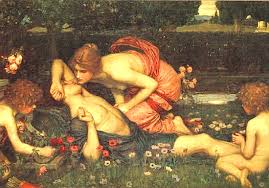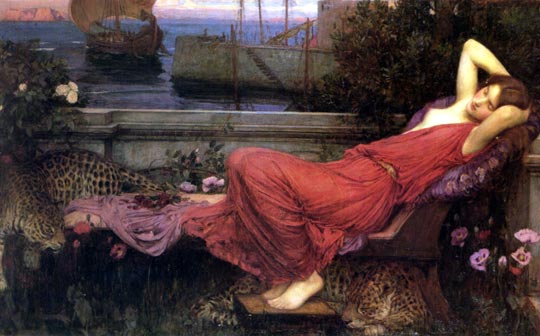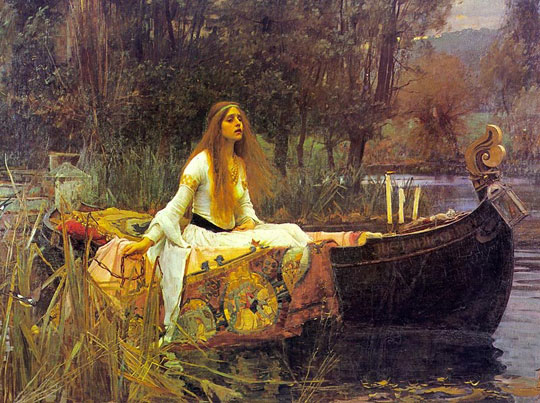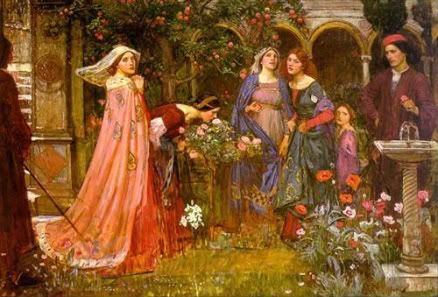I came across this intriguing painting the other day and wondered what the story was behind it.
which showed the sleeping figure outstretched at the moment of her abandonment by Theseus. Two years later Waterhouse showed the Awakening of Adonis,

where again the main protagonist seems hardly aware of the unfolding drama. Waterhouse's paintings after the turn of the century were to become blander and more oblique in their storytelling, and seldom again did he achieve the psychological tension and sense of frenzied excitement of Flora and the Zephyrs.
Waterhouse had been suffering from cancer for some time and in 1916 while he continued to work on The Enchanted Garden
he was approaching the end of his journey. A beautiful planter decorated with grapevines, deer and birds (of a type that may be found in an enchanted garden) now rests upon the slab that covers the Waterhouse gravesite at Kensal Green Cemetery.
"The painting makes a fitting epitaph - for what is the work of Waterhouse - if not an enchanted garden"!.
John William Waterhouse died on 10 February 1917 before the painting was finished.
His art continues to bring joy and inspiration to many.
| Flora and the Zephyrs
by
John William Waterhouse |
| detail |
| charcoal study |
John William Waterhouse's Flora and the Zephyrs takes its subject from Ovid's Fasti, which is a verse chronicle of the Roman calendar, and which incorporates the mythologies and historical legends of Rome where they can he associated with specific times of the year. Waterhouse's painting shows the moment when Zephyr first set eyes upon and fell in love with Flora, as she gathered flowers in the fields with her maidens and children. He flies down to her, accompanied by his winged companions, and captures her by casting a garland of white flowers around her.
Flora and the Zephyrs was exhibited at the Royal Academy in 1898 with Ariadne (private collection),
 |
| Ariadne was the daughter of King Minos of Crete |
where again the main protagonist seems hardly aware of the unfolding drama. Waterhouse's paintings after the turn of the century were to become blander and more oblique in their storytelling, and seldom again did he achieve the psychological tension and sense of frenzied excitement of Flora and the Zephyrs.
 |
| Probably Waterhouse's most famous work The Lady of Shallot |
 |
| The Enchanted Garden |
"The painting makes a fitting epitaph - for what is the work of Waterhouse - if not an enchanted garden"!.
John William Waterhouse died on 10 February 1917 before the painting was finished.
His art continues to bring joy and inspiration to many.
I have used two of his paintings to illustrate a post on The Scented Garden - Roses here on my other blog Ramblings from Rosebank


Lady of Shallot one of my favourite paintings lovely work by a supreme artist
ReplyDeleteThey are probably thought of as old-fashioned now but I find them very moving.
DeleteI've loved the pre-Raphaelite's since my days at Uni. I had a poster of 'The Boer War' on my classroom wall for years.... Hmmm, I wonder what happened to it? Jx
ReplyDeleteI have never heard of this painting so just Googled it - a strange title I thought not very relevant to what I was looking at - so I found an article about it.
DeleteNow it makes sense. Not a picture of the Boer War - but a woman left behind or in mourning. Not your typical pre-raphaelite painting - but beautiful if not rather sad.
Not to my taste but an interesting post. Flighty xx
ReplyDeleteI can understand that - but you have to admit the paintings are very skilful.
DeleteI generally have much admiration for the skills of artists. Flighty xx
DeleteWhat beautiful paintings, Elaine. The first one takes the take for me, but I love them all. :-)
ReplyDeleteThere is so much to look at in the painting - and it is good to know the story behind it.
DeleteLovely post! We were wandering around the Pre-Raphaelite paintings at the Birmingham Museum recently. They certainly bring out some strong emotions in people, some of them I like very much some I don't. Two of my favourites are 'The Last of England' and 'Work' by Ford Madox Brown. Some of the paintings like 'The Lady of Shallot' remind me of childhood book illustrations of poems, fables and fairy tales. I do enjoy reading about the lives of the artists and how they created their paintings and why:)
ReplyDeleteFascinating stuff - I don't recognise the two you mentioned so I'll look them up - always learning.
Delete